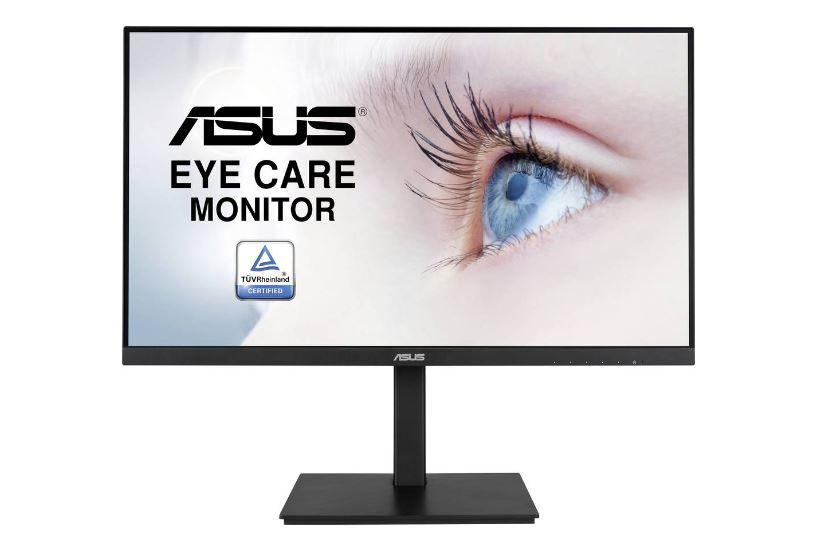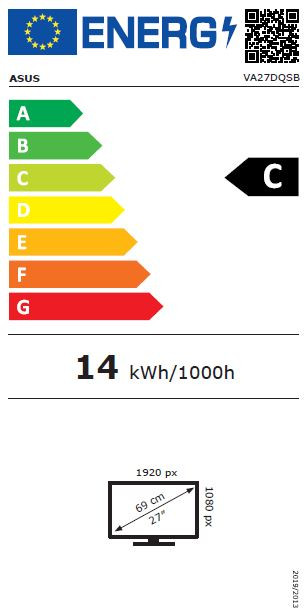



























£195.22*
- Resolution 1920 x 1080 Full HD
- Diagonal 27"
- Panel type IPS
- Refresh Rate 75Hz



Product information
ASUS VA27DQSB Eye Care Monitor - 68.58cm (27 inch), FHD (Full HD 1920x1080), IPS, frameless design, 75Hz, Adaptive-Sync, DisplayPort, HDMI, Eye Care, Low Blue Light, Flicker Free, compatible with wall mounts.
- 68.58cm (27 inch) Full HD (1920x1080), IPS display with LED backlight and wide viewing angle of 178°
- A refresh rate of up to 75Hz with Adaptive-Sync technology prevents lagging effects and ensures sharp, crystal clear video playback
- Comprehensive connectivity options including HDMI, DisplayPort, D-Sub and a USB hub
- Ergonomic design with 150mm height adjustment as well as 180° swivel, +35° ~ -5° tilt and 90° pivot function for comfortable use
- ASUS Eye-Care monitors feature TÜV Rheinland certified Flicker-Free and Low-Blue-Light technologies for extra comfortable use
- Supports both Adaptive-Sync with NVIDIA GeForce graphics cards and FreeSync with AMD Radeon graphics cards. *Compatible with NVIDIA-GeForce GTX-10, GTX-16, RTX-20 and newer graphics cards.
VA27DQSB Eye Care Monitor
The ASUS VA27DQSB is a 68.58cm (27 inch) full HD monitor with a frameless IPS panel for high viewing angles. As a result, it delivers incredibly sharp images and stunning video playback. A refresh rate of up to 75Hz with Adaptive Sync technology prevents lagging effects and ensures sharp, crystal-clear video playback. The extra ergonomic design with height adjustment as well as tilt, swivel and swivel functions, together with TÜV Rheinland certified Flicker-Free and Low-Blue-Light technologies, ensure a comfortable viewing experience.
True-to-life reproduction with 178° viewing angles
Full HD resolution and a frameless IPS panel for a 178° viewing angle - both horizontally and vertically - so you can enjoy the high picture quality from almost any direction.
Multiple connectivity options
A variety of connectivity options, including HDMI, DisplayPort, D-Sub and a USB hub, ensure that the monitor connects easily to a wide range of PCs, notebooks, consoles, multimedia boxes, keyboards and mice. In addition, the monitor has pass-through interfaces for line-in and headphone connection, which are conveniently accessible.
Versatile, ergonomic stand for individual comfort
A comfortable viewing position is possible in a few simple steps thanks to the ergonomically designed stand with height adjustment as well as tilt, turn and swivel functions. The various alignment options make working more comfortable and increase productivity. The screen can be rotated vertically by 90° for use in portrait mode. This has many advantages when working with long documents, writing code or browsing large websites.
In-game enhancements
Adaptive Sync technology prevents tearing and compensates for fluctuating frame rates for smooth gameplay with seamless visuals. So you'll always have the upper hand, whether you're playing first-person shooters, racing games, real-time strategy or sports titles. (Adaptive-Sync works at refresh rates ranging from 48Hz to 75Hz). Get more out of your game with the ASUS-exclusive GamePlus hotkey. This feature has been developed in collaboration with professional gamers to help them train and improve their gaming skills.
ASUS Blue Light Filter
The exclusive ASUS Blue Light Filter protects you from harmful blue light. The filter is conveniently accessible via the OSD menu and offers intuitive, flexible operation with infinite settings (0 to maximum).
ASUS Flicker-Free Technology
Tired and strained eyes are a thing of the past. Flicker-Free technology reduces screen flicker and provides a particularly comfortable environment suitable for movie marathons. It is designed to minimise eyestrain, headaches and eye fatigue - symptoms that can occur after countless hours in front of the screen.
Exclusive ASUS features for added flexibility
Splendid - Video Intelligence Technology
The exclusive ASUS Splendid™ technology optimises picture quality by analysing the individual pixels of a full screen image. This allows the brightness, contrast, sharpness and colours to be optimally adjusted. There are a variety of preset modes to choose from - including Reading, Darkroom, Landscape, Standard, Theatre, sRGB, Gaming and Night modes.
Smart cable management
Cable management helps to organise and hide the various cables to keep the desk uncluttered.
Technical data
| Name | Asus VA27DQSB Eye Care Monitor 27" IPS Monitor, 1920 x 1080 Full HD, 75Hz, 5ms |
|---|---|
| Article number | 1000025150 |
| GTIN/EAN | 4718017756426 |
| Manufacturer SKU | 90LM06H1-B02370 |
| EPREL ID | 388063 |
| Model name | VA27DQSB Eye Care Monitor |
| Brand | Asus |
| Product Type | Monitor |
| Product Series | Asus VA Series |
| Technology | LCD |
| Panel type | IPS |
| Resolution | 1920 x 1080 Full HD |
| Diagonal | 27" |
| Aspect Ratio | 16:9 |
| Viewing angle - Horizontal | 178° |
| Viewing angle - Vertical | 178° |
| Contrast Ratio | 1,200 :1 |
| Max. Brightness | 250 cd/m² |
| Response time | 5ms |
| Refresh Rate | 75Hz |
| Support - VESA | 100 x 100 |
| Inputs | 1x Displayport , 1x HDMI , 1x VGA , 2x USB-A |
| Features | Flicker Free , Integrated speaker |
| Product width | 61.19 cm |
| Product height | 36.47 cm |
| Product depth | 5.55 cm |
| Weight | 4.5 kg |
| Colour | Black |
| EEK Spectrum | A to G |
| Energy efficency class | C |
| Delivery contents | Power cable , USB cable , warranty card |
| Condition | New |
| Warranty | 24 Month |
| Warranty type | Bringin service Service and support information |
Downloads
Product safety
| Person responsible for the EU |
|---|
| Ninepoint GmbH |
| Im Mediapark 8 |
| 50670 Köln |
| Germany |
| info@asus-shop.de |



